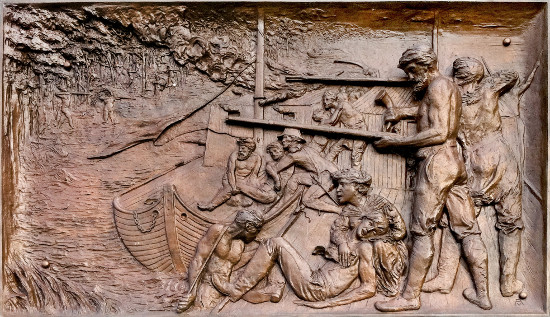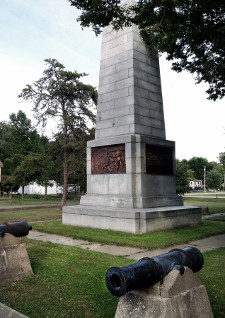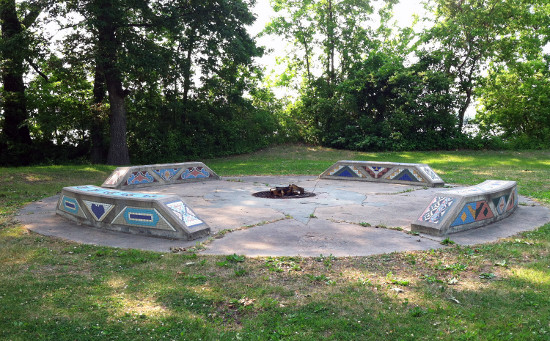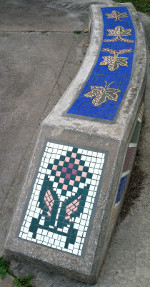
On Campbell's Island is a war memorial side-by-side with an artwork dedicated to peace. One rises imposingly; the other is unassumingly low to the ground. Together, they give us a greater perspective on the area's history than if we were to consider them separately.
 Campbell's Island is just north of East Moline, accessible from Illinois Route 84. The island is named for U.S. Lieutenant John Campbell, who was leading three gunboats past it on July 19, 1814, when his boat was grounded during a storm. While vulnerable, they were attacked by an estimated 500 Sauk warriors allied with the British Army. The attack led by Black Hawk and the ensuing fight became known as the Battle of Rock Island Rapids - one of the most western battles of the War of 1812. In all, there were between 35 and 37 casualities (depending on the source) among Campbell's men and their families - including the deaths of 14 men, a woman, and a child.
Campbell's Island is just north of East Moline, accessible from Illinois Route 84. The island is named for U.S. Lieutenant John Campbell, who was leading three gunboats past it on July 19, 1814, when his boat was grounded during a storm. While vulnerable, they were attacked by an estimated 500 Sauk warriors allied with the British Army. The attack led by Black Hawk and the ensuing fight became known as the Battle of Rock Island Rapids - one of the most western battles of the War of 1812. In all, there were between 35 and 37 casualities (depending on the source) among Campbell's men and their families - including the deaths of 14 men, a woman, and a child.
In 1908, the Campbell's Island State Memorial was dedicated on the site where the lieutenant's boat lay derelict for years. The monument is maintained by the Illinois Historic Preservation Agency as a state historic site.
The granite memorial is primarily an obelisk, a four-sided shaft topped by a pyramid. Though not as monumental in scale as ancient Egyptian and Roman obelisks - another example of an obelisk is the Washington Monument - its approximate height of 35 feet is impressive and unexpected on a small, residential island.
An eight-foot bronze relief is on the side of the memorial facing the Mississippi, where the Rock Island Rapids were once located. It is attributed to Albert Louis Van den Berghen, a Chicago-area sculptor who lived from 1850 to 1921 and is probably best known for a standing sculpture of Lincoln in Racine, Wisconsin, and the Maryland Line Monument in Baltimore.
The artwork depicts the rescue of men on Campbell's boat while they are being fired on by muskets and arrows at close range. The middle third of the composition is dominated by three groups of figures. Lieutenant Campbell, shot through his chest and wrist, lies wounded in the exact center of the relief.
The middle section is flanked by soldiers and warriors firing weapons. Though the Sauk are much smaller and barely stand out from the surrounding woods, the principal figures are placed on both sides somewhat symmetrically. The smoke rising from the burning sails (Black Hawk later claimed to have shot the flaming arrows that set the fire) is intersected by the diagonal edge of the boat and the falling flag.
Though the tight framing of the soldiers and their raised muskets gives the composition a certain rigidness, the figures are skillfully rendered - fluid and gestural, with their facial expressions really bringing the event to life. The relief's surface is active and is a welcome contrast to an otherwise austere monument.

 Southwest of the memorial is the Peace Garden, a 30-foot circle with four benches placed around a center fire grate. The benches are decorated with mosaic-tile designs adapted from 19th Century Sauk and Mesquakie beadwork and artifacts.
Southwest of the memorial is the Peace Garden, a 30-foot circle with four benches placed around a center fire grate. The benches are decorated with mosaic-tile designs adapted from 19th Century Sauk and Mesquakie beadwork and artifacts.
Within the circle is an abstracted outline of a large turtle on the concrete surface. The turtle represents the Earth and ground to the Mesquakie tribe. The circle itself is a sacred symbol; among its many meanings, it represents the cycle of life and the seasons.
The Peace Garden was developed under the guidance of artist and facilitator Kunhild Blacklock with assistance from Campbell's Island residents, Mesquakie spiritual leader Preston Duncan, and other community leaders. It was dedicated in 1998, 90 years after the dedication of the state memorial. The Peace Garden was designed to honor the Native American history of the Quad Cities - a marked contrast to their depiction and role in the nearby war memorial.
Bruce Walters is a professor of art at Western Illinois University.
This is part of an occasional series on the history of public art in the Quad Cities. If there's a piece of public art that you'd like to learn more about, e-mail the location and a brief description to BD-Walters@wiu.edu.








